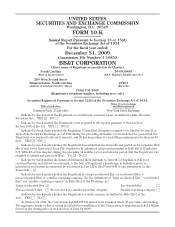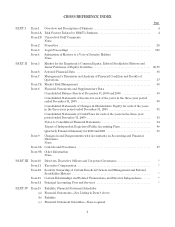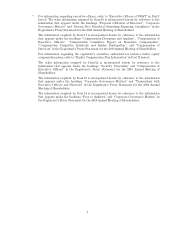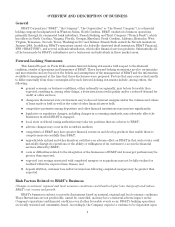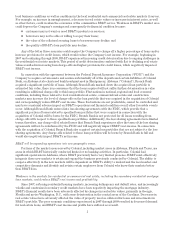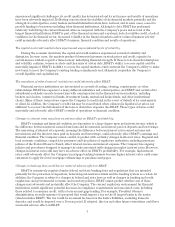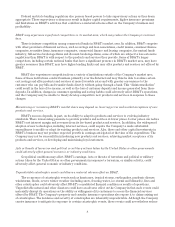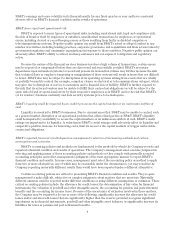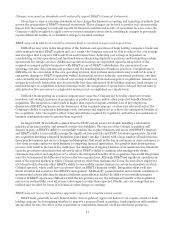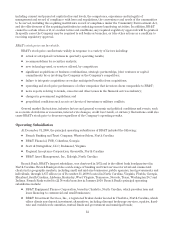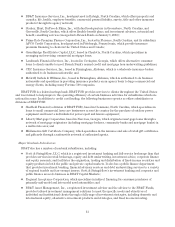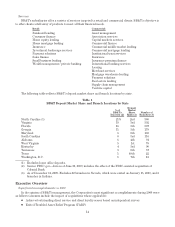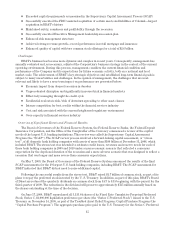BB&T 2009 Annual Report Download - page 7
Download and view the complete annual report
Please find page 7 of the 2009 BB&T annual report below. You can navigate through the pages in the report by either clicking on the pages listed below, or by using the keyword search tool below to find specific information within the annual report.experienced significant challenges, its credit quality has deteriorated and its net income and results of operations
have been adversely impacted. Reflecting concern about the stability of the financial markets generally and the
strength of counterparties, many lenders and institutional investors have reduced, and in some cases, ceased to
provide funding to borrowers including other financial institutions. Although to date BB&T has performed
relatively well during the current financial crisis as compared with the Company’s peers and several of the
largest financial institutions, BB&T is part of the financial system and a systemic lack of available credit, a lack of
confidence in the financial sector, increased volatility in the financial markets and/or reduced business activity
could materially adversely affect BB&T’s business, financial condition and results of operations.
The capital and credit markets have experienced unprecedented levels of volatility.
During the economic downturn, the capital and credit markets experienced extended volatility and
disruption. In some cases, the markets produced downward pressure on stock prices and credit capacity for
certain issuers without regard to those issuers’ underlying financial strength. If these levels of market disruption
and volatility continue, worsen or abate and then arise at a later date, BB&T’s ability to access capital could be
materially impaired. BB&T’s inability to access the capital markets could constrain the Company’s ability to make
new loans, to meet the Company’s existing lending commitments and, ultimately jeopardize the Company’s
overall liquidity and capitalization.
The soundness of other financial institutions could adversely affect BB&T.
Financial services institutions are interrelated as a result of trading, clearing, counterparty, or other
relationships. BB&T has exposure to many different industries and counterparties, and BB&T and certain of its
subsidiaries routinely execute transactions with counterparties in the financial services industry, including
brokers and dealers, commercial banks, investment banks, mutual and hedge funds, and other institutional
clients. Many of these transactions expose the Company to credit risk in the event of default of its counterparty
or client. In addition, the Company’s credit risk may be exacerbated when collateral is liquidated at prices not
sufficient to recover the full amount of the loan or derivative exposure due BB&T. These types of losses could
materially and adversely affect BB&T’s results of operations or financial condition.
Changes in interest rates may have an adverse effect on BB&T’s profitability.
BB&T’s earnings and financial condition are dependent to a large degree upon net interest income, which is
the difference between interest earned from loans and investments and interest paid on deposits and borrowings.
The narrowing of interest rate spreads, meaning the difference between interest rates earned on loans and
investments and the interest rates paid on deposits and borrowings, could adversely affect BB&T’s earnings and
financial condition. The Company cannot control or predict with certainty changes in interest rates. Regional and
local economic conditions, competitive pressures and the policies of regulatory authorities, including monetary
policies of the Federal Reserve Board, affect interest income and interest expense. The Company has ongoing
policies and procedures designed to manage the risks associated with changes in market interest rates. However,
changes in interest rates still may have an adverse effect on BB&T’s profitability. For example, high interest
rates could adversely affect the Company’s mortgage banking business because higher interest rates could cause
customers to apply for fewer mortgage refinancings or purchase mortgages.
Changes in banking laws could have a material adverse effect on BB&T.
BB&T is extensively regulated under federal and state banking laws and regulations that are intended
primarily for the protection of depositors, federal deposit insurance funds and the banking system as a whole. In
addition, the Company is subject to changes in federal and state laws as well as changes in banking and credit
regulations, and governmental economic and monetary policies. BB&T cannot predict whether any of these
changes may adversely and materially affect the Company. The current regulatory environment for financial
institutions entails significant potential increases in compliance requirements and associated costs, including
those related to consumer credit, with a focus on mortgage lending. For example, President Obama’s
administration recently announced a proposal that would impose a tax on the 50 largest banks in the nation
(which includes BB&T). The tax would be an annual fee based on the bank’s liabilities, excluding domestic
deposits, and would be imposed over a 10 year period. If adopted, this tax and other future restrictions could have
a material adverse effect on BB&T.
7

